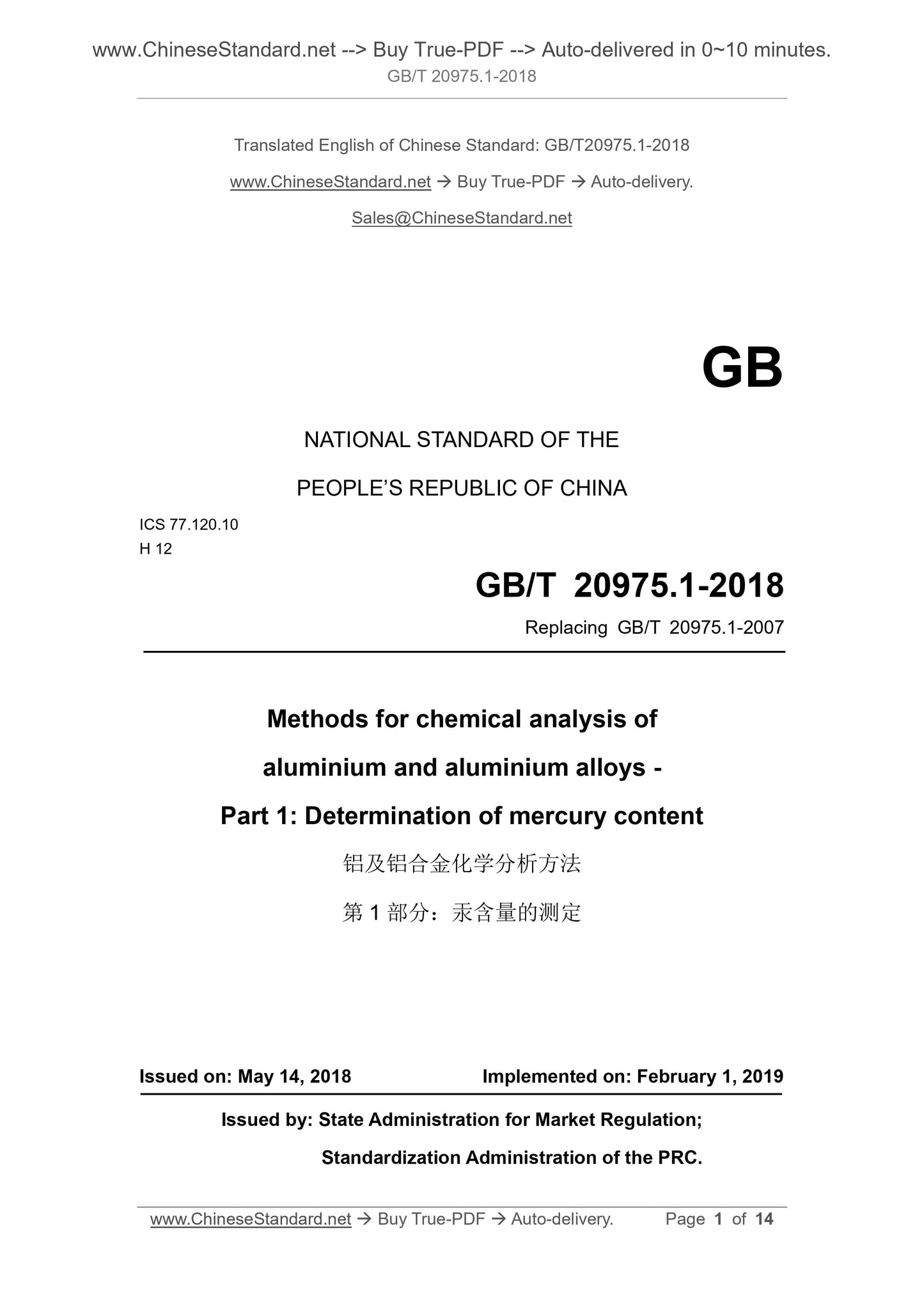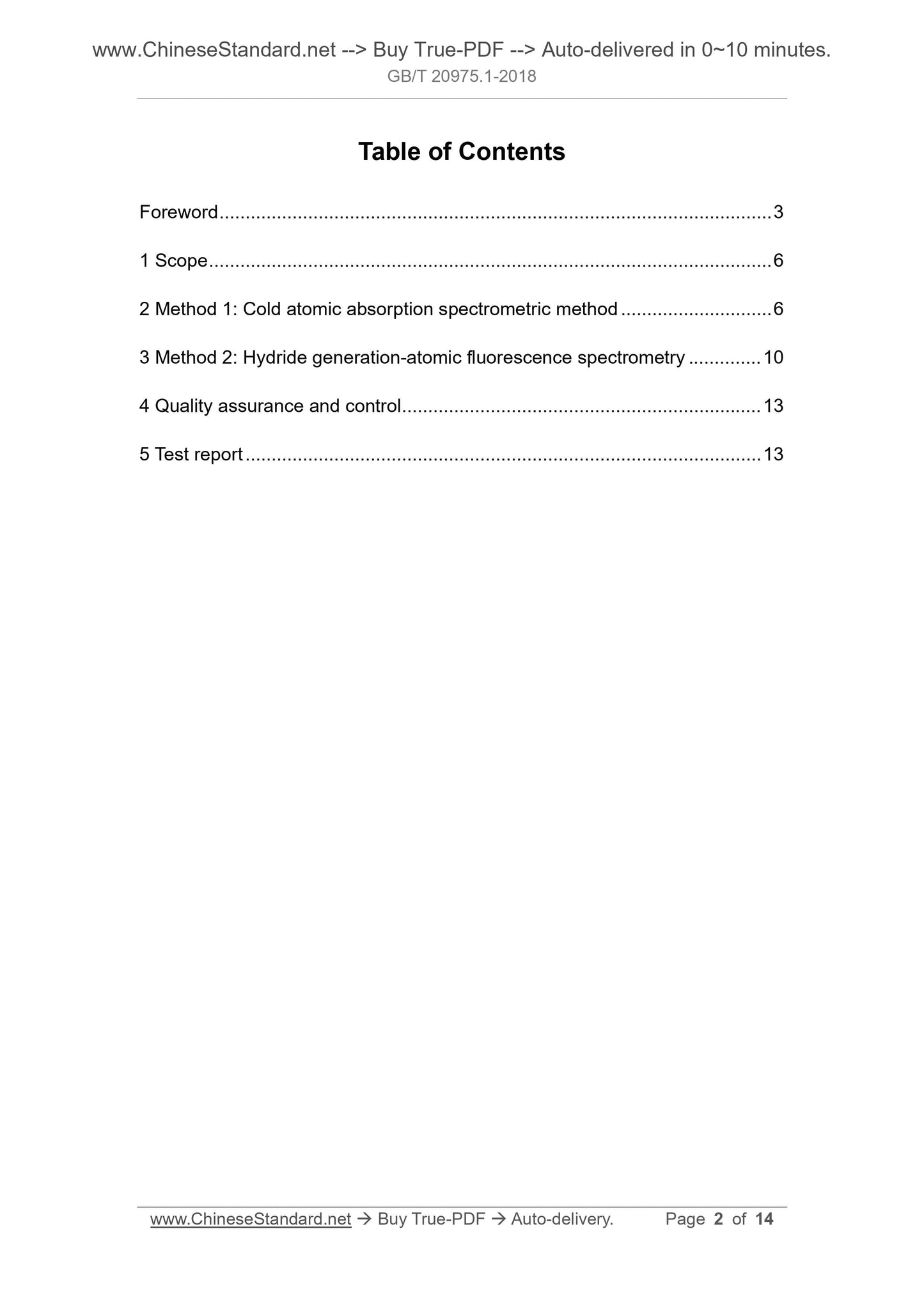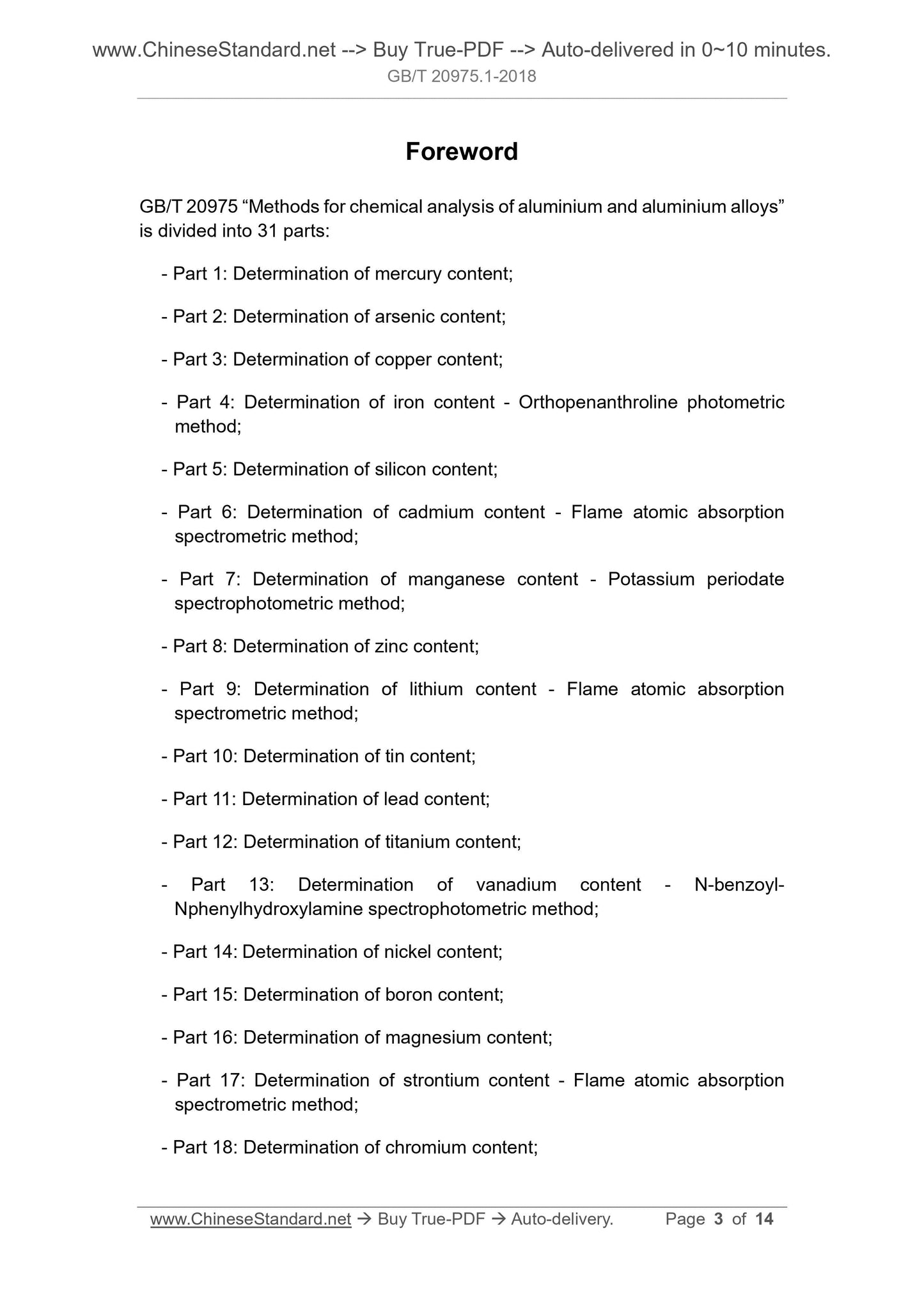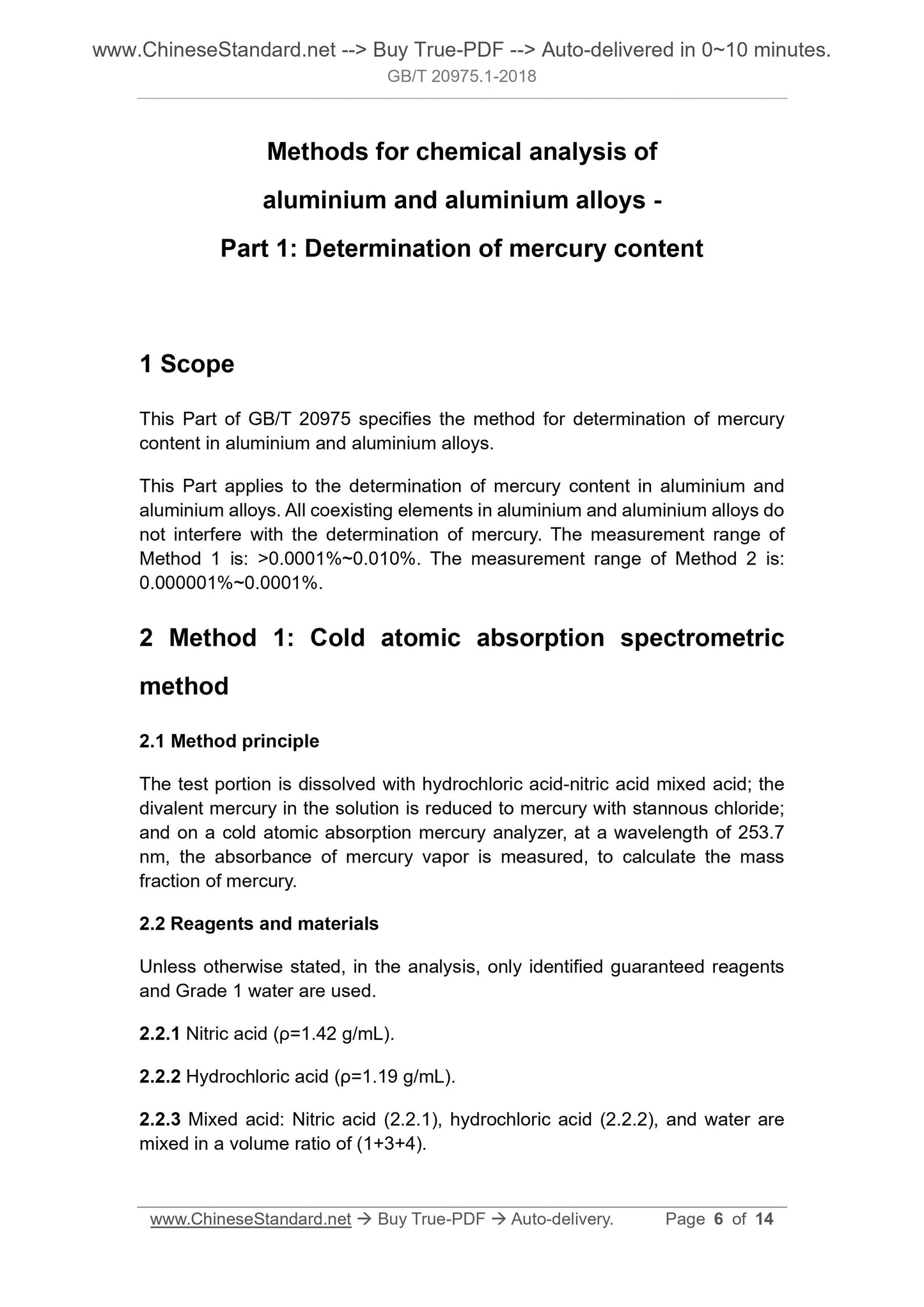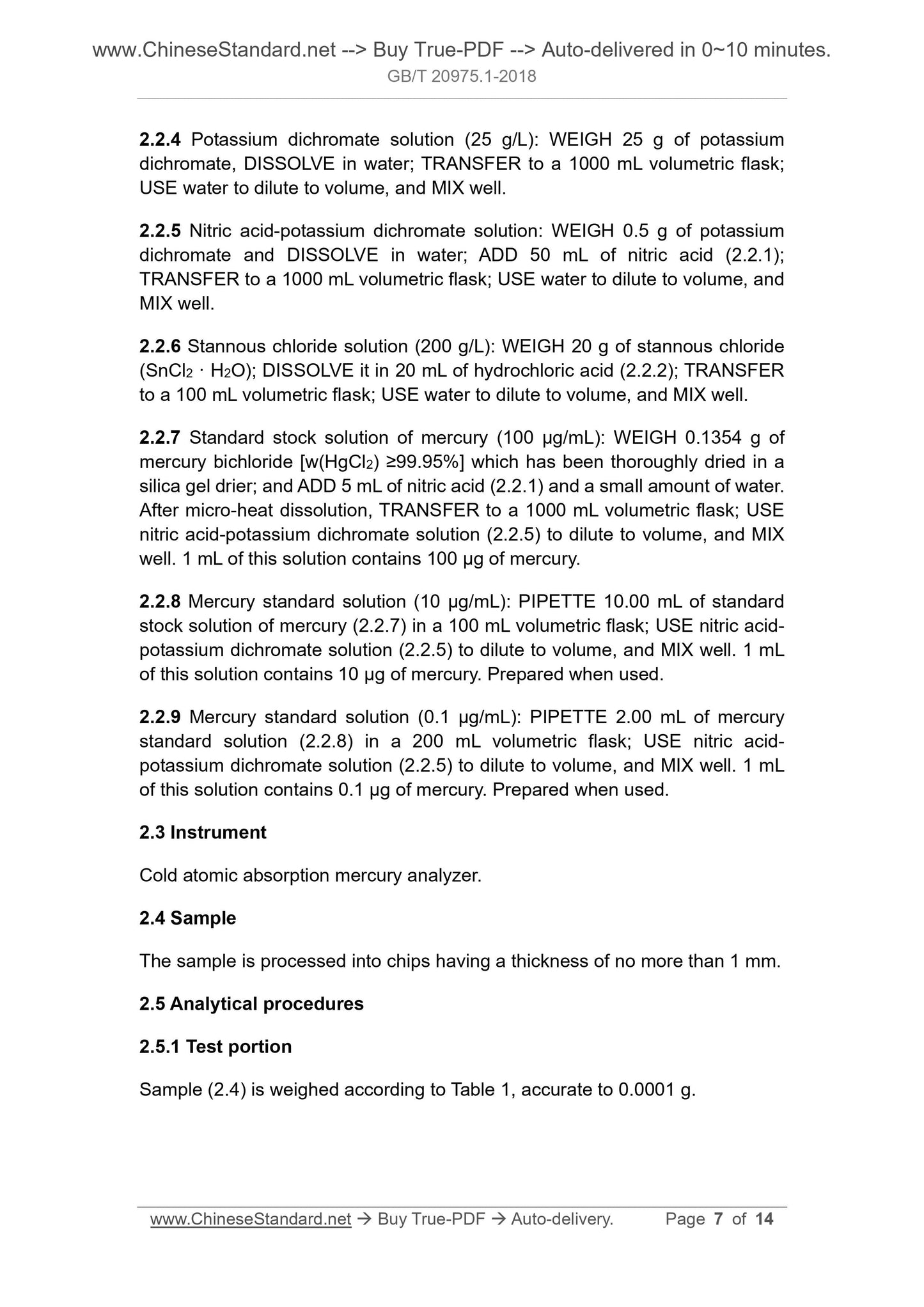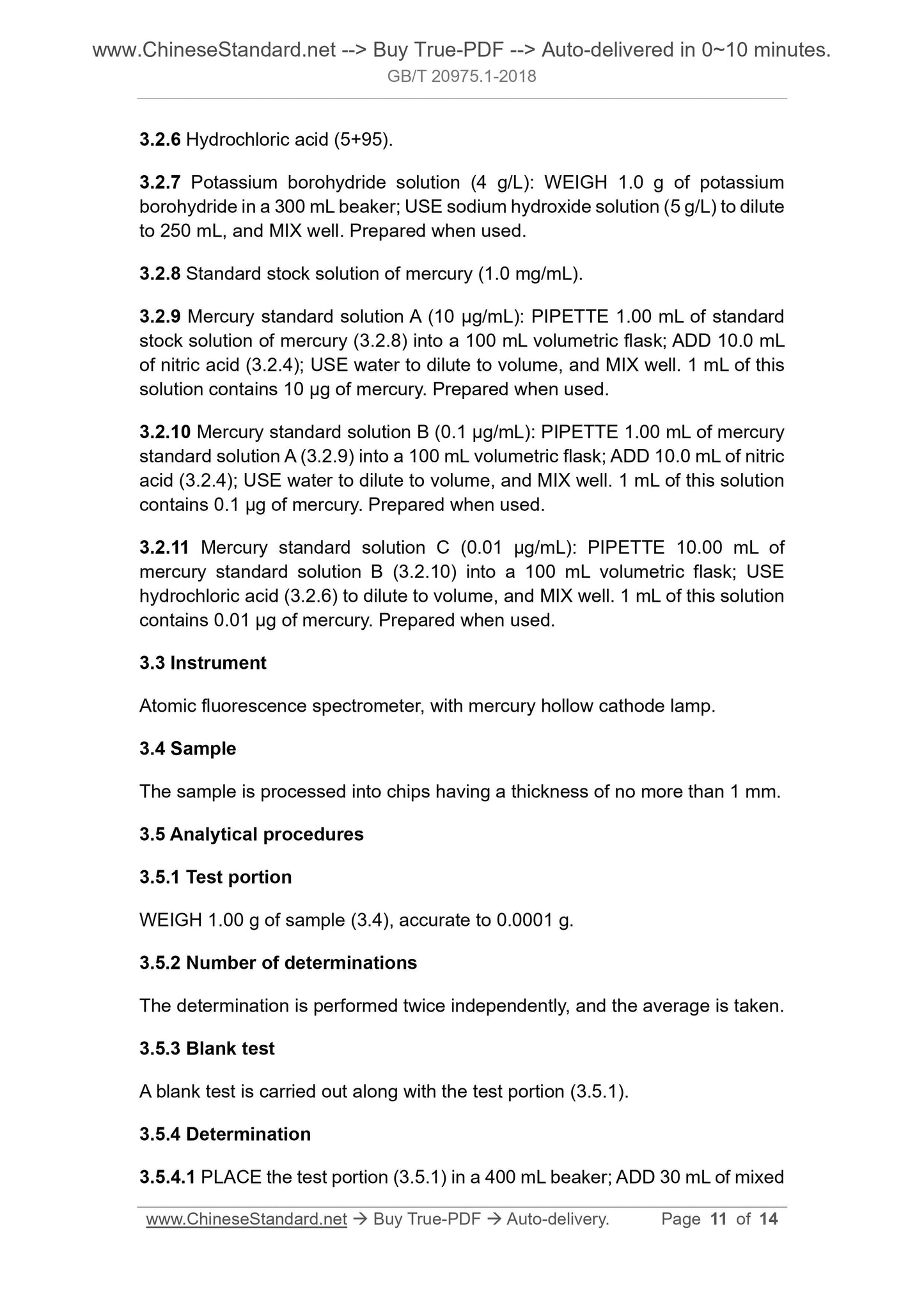1
/
of
6
www.ChineseStandard.us -- Field Test Asia Pte. Ltd.
GB/T 20975.1-2018 English PDF (GB/T20975.1-2018)
GB/T 20975.1-2018 English PDF (GB/T20975.1-2018)
Regular price
$150.00
Regular price
Sale price
$150.00
Unit price
/
per
Shipping calculated at checkout.
Couldn't load pickup availability
GB/T 20975.1-2018: Methods for chemical analysis of aluminium and aluminium alloys - Part 1: Determination of mercury content
Delivery: 9 seconds. Download (& Email) true-PDF + Invoice.
Get Quotation: Click GB/T 20975.1-2018 (Self-service in 1-minute)
Historical versions (Master-website): GB/T 20975.1-2018
Preview True-PDF (Reload/Scroll-down if blank)
GB/T 20975.1-2018
GB
NATIONAL STANDARD OF THE
PEOPLE’S REPUBLIC OF CHINA
ICS 77.120.10
H 12
Replacing GB/T 20975.1-2007
Methods for chemical analysis of
aluminium and aluminium alloys -
Part 1. Determination of mercury content
ISSUED ON. MAY 14, 2018
IMPLEMENTED ON. FEBRUARY 1, 2019
Issued by. State Administration for Market Regulation;
Standardization Administration of the PRC.
Table of Contents
Foreword ... 3
1 Scope ... 6
2 Method 1. Cold atomic absorption spectrometric method ... 6
3 Method 2. Hydride generation-atomic fluorescence spectrometry ... 10
4 Quality assurance and control ... 13
5 Test report ... 13
Foreword
GB/T 20975 “Methods for chemical analysis of aluminium and aluminium alloys”
is divided into 31 parts.
- Part 1. Determination of mercury content;
- Part 2. Determination of arsenic content;
- Part 3. Determination of copper content;
- Part 4. Determination of iron content - Orthopenanthroline photometric
method;
- Part 5. Determination of silicon content;
- Part 6. Determination of cadmium content - Flame atomic absorption
spectrometric method;
- Part 7. Determination of manganese content - Potassium periodate
spectrophotometric method;
- Part 8. Determination of zinc content;
- Part 9. Determination of lithium content - Flame atomic absorption
spectrometric method;
- Part 10. Determination of tin content;
- Part 11. Determination of lead content;
- Part 12. Determination of titanium content;
- Part 13. Determination of vanadium content - N-benzoyl-
Nphenylhydroxylamine spectrophotometric method;
- Part 14. Determination of nickel content;
- Part 15. Determination of boron content;
- Part 16. Determination of magnesium content;
- Part 17. Determination of strontium content - Flame atomic absorption
spectrometric method;
- Part 18. Determination of chromium content;
Methods for chemical analysis of
aluminium and aluminium alloys -
Part 1. Determination of mercury content
1 Scope
This Part of GB/T 20975 specifies the method for determination of mercury
content in aluminium and aluminium alloys.
This Part applies to the determination of mercury content in aluminium and
aluminium alloys. All coexisting elements in aluminium and aluminium alloys do
not interfere with the determination of mercury. The measurement range of
Method 1 is. >0.0001%~0.010%. The measurement range of Method 2 is.
0.000001%~0.0001%.
2 Method 1. Cold atomic absorption spectrometric
method
2.1 Method principle
The test portion is dissolved with hydrochloric acid-nitric acid mixed acid; the
divalent mercury in the solution is reduced to mercury with stannous chloride;
and on a cold atomic absorption mercury analyzer, at a wavelength of 253.7
nm, the absorbance of mercury vapor is measured, to calculate the mass
fraction of mercury.
2.2 Reagents and materials
Unless otherwise stated, in the analysis, only identified guaranteed reagents
and Grade 1 water are used.
2.2.1 Nitric acid (ρ=1.42 g/mL).
2.2.2 Hydrochloric acid (ρ=1.19 g/mL).
2.2.3 Mixed acid. Nitric acid (2.2.1), hydrochloric acid (2.2.2), and water are
mixed in a volume ratio of (1+3+4).
2.2.4 Potassium dichromate solution (25 g/L). WEIGH 25 g of potassium
dichromate, DISSOLVE in water; TRANSFER to a 1000 mL volumetric flask;
USE water to dilute to volume, and MIX well.
2.2.5 Nitric acid-potassium dichromate solution. WEIGH 0.5 g of potassium
dichromate and DISSOLVE in water; ADD 50 mL of nitric acid (2.2.1);
TRANSFER to a 1000 mL volumetric flask; USE water to dilute to volume, and
MIX well.
2.2.6 Stannous chloride solution (200 g/L). WEIGH 20 g of stannous chloride
(SnCl2 · H2O); DISSOLVE it in 20 mL of hydrochloric acid (2.2.2); TRANSFER
to a 100 mL volumetric flask; USE water to dilute to volume, and MIX well.
2.2.7 Standard stock solution of mercury (100 μg/mL). WEIGH 0.1354 g of
mercury bichloride [w(HgCl2) ≥99.95%] which has been thoroughly dried in a
silica gel drier; and ADD 5 mL of nitric acid (2.2.1) and a small amount of water.
After micro-heat dissolution, TRANSFER to a 1000 mL volumetric flask; USE
nitric acid-potassium dichromate solution (2.2.5) to dilute to volume, and MIX
well. 1 mL of this solution contains 100 μg of mercury.
2.2.8 Mercury standard solution (10 μg/mL). PIPETTE 10.00 mL of standard
stock solution of mercury (2.2.7) in a 100 mL volumetric flask; USE nitric acid-
potassium dichromate solution (2.2.5) to dilute to volume, and MIX well. 1 mL
of this solution contains 10 μg of mercury. Prepared when used.
2.2.9 Mercury standard solution (0.1 μg/mL). PIPETTE 2.00 mL of mercury
standard solution (2.2.8) in a 200 mL volumetric flask; USE nitric acid-
potassium dichromate solution (2.2.5) to dilute to volume, and MIX well. 1 mL
of this solution contains 0.1 μg of mercury. Prepared when used.
2.3 Instrument
Cold atomic absorption mercury analyzer.
2.4 Sample
The sample is processed into chips having a thickness of no more than 1 mm.
2.5 Analytical procedures
2.5.1 Test portion
Sample (2.4) is weighed according to Table 1, accurate to 0.0001 g.
3.2.6 Hydrochloric acid (5+95).
3.2.7 Potassium borohydride solution (4 g/L). WEIGH 1.0 g of potassium
borohydride in a 300 mL beaker; USE sodium hydroxide solution (5 g/L) to dilute
to 250 mL, and MIX well. Prepared when used.
3.2.8 Standard stock solution of mercury (1.0 mg/mL).
3.2.9 Mercury standard solution A (10 μg/mL). PIPETTE 1.00 mL of standard
stock solution of mercury (3.2.8) into a 100 mL volumetric flask; ADD 10.0 mL
of nitric acid (3.2.4); USE water to dilute to volume, and MIX well. 1 mL of this
solution contains 10 μg of mercury. Prepared when used.
3.2.10 Mercury standard solution B (0.1 μg/mL). PIPETTE 1.00 mL of mercury
standard solution A (3.2.9) into a 100 mL volumetric flask; ADD 10.0 mL of nitric
acid (3.2.4); USE water to dilute to volume, and MIX well. 1 mL of this solution
contains 0.1 μg of mercury. Prepared when used.
3.2.11 Mercury standard solution C (0.01 μg/mL). PIPETTE 10.00 mL of
mercury standard solution B (3.2.10) into a 100 mL volumetric flask; USE
hydrochloric acid (3.2.6) to dilute to volume, and MIX well. 1 mL of this solution
contains 0.01 μg of mercury. Prepared when used.
3.3 Instrument
Atomic fluorescence spectrometer, with mercury hollow cathode lamp.
3.4 Sample
The sample is processed into chips having a thickness of no more than 1 mm.
3.5 Analytical procedures
3.5.1 Test portion
WEIGH 1.00 g of sample (3.4), accurate to 0.0001 g.
3.5.2 Number of determinations
The determination is performed twice independently, and the average is taken.
3.5.3 Blank test
A blank test is carried out along with the test portion (3.5.1).
3.5.4 Determination
3.5.4.1 PLACE the test portion (3.5.1) in a 400 mL beaker; ADD 30 mL of mixed
GB/T 20975.1-2018
GB
NATIONAL STANDARD OF THE
PEOPLE’S REPUBLIC OF CHINA
ICS 77.120.10
H 12
Replacing GB/T 20975.1-2007
Methods for chemical analysis of
aluminium and aluminium alloys -
Part 1. Determination of mercury content
ISSUED ON. MAY 14, 2018
IMPLEMENTED ON. FEBRUARY 1, 2019
Issued by. State Administration for Market Regulation;
Standardization Administration of the PRC.
Table of Contents
Foreword ... 3
1 Scope ... 6
2 Method 1. Cold atomic absorption spectrometric method ... 6
3 Method 2. Hydride generation-atomic fluorescence spectrometry ... 10
4 Quality assurance and control ... 13
5 Test report ... 13
Foreword
GB/T 20975 “Methods for chemical analysis of aluminium and aluminium alloys”
is divided into 31 parts.
- Part 1. Determination of mercury content;
- Part 2. Determination of arsenic content;
- Part 3. Determination of copper content;
- Part 4. Determination of iron content - Orthopenanthroline photometric
method;
- Part 5. Determination of silicon content;
- Part 6. Determination of cadmium content - Flame atomic absorption
spectrometric method;
- Part 7. Determination of manganese content - Potassium periodate
spectrophotometric method;
- Part 8. Determination of zinc content;
- Part 9. Determination of lithium content - Flame atomic absorption
spectrometric method;
- Part 10. Determination of tin content;
- Part 11. Determination of lead content;
- Part 12. Determination of titanium content;
- Part 13. Determination of vanadium content - N-benzoyl-
Nphenylhydroxylamine spectrophotometric method;
- Part 14. Determination of nickel content;
- Part 15. Determination of boron content;
- Part 16. Determination of magnesium content;
- Part 17. Determination of strontium content - Flame atomic absorption
spectrometric method;
- Part 18. Determination of chromium content;
Methods for chemical analysis of
aluminium and aluminium alloys -
Part 1. Determination of mercury content
1 Scope
This Part of GB/T 20975 specifies the method for determination of mercury
content in aluminium and aluminium alloys.
This Part applies to the determination of mercury content in aluminium and
aluminium alloys. All coexisting elements in aluminium and aluminium alloys do
not interfere with the determination of mercury. The measurement range of
Method 1 is. >0.0001%~0.010%. The measurement range of Method 2 is.
0.000001%~0.0001%.
2 Method 1. Cold atomic absorption spectrometric
method
2.1 Method principle
The test portion is dissolved with hydrochloric acid-nitric acid mixed acid; the
divalent mercury in the solution is reduced to mercury with stannous chloride;
and on a cold atomic absorption mercury analyzer, at a wavelength of 253.7
nm, the absorbance of mercury vapor is measured, to calculate the mass
fraction of mercury.
2.2 Reagents and materials
Unless otherwise stated, in the analysis, only identified guaranteed reagents
and Grade 1 water are used.
2.2.1 Nitric acid (ρ=1.42 g/mL).
2.2.2 Hydrochloric acid (ρ=1.19 g/mL).
2.2.3 Mixed acid. Nitric acid (2.2.1), hydrochloric acid (2.2.2), and water are
mixed in a volume ratio of (1+3+4).
2.2.4 Potassium dichromate solution (25 g/L). WEIGH 25 g of potassium
dichromate, DISSOLVE in water; TRANSFER to a 1000 mL volumetric flask;
USE water to dilute to volume, and MIX well.
2.2.5 Nitric acid-potassium dichromate solution. WEIGH 0.5 g of potassium
dichromate and DISSOLVE in water; ADD 50 mL of nitric acid (2.2.1);
TRANSFER to a 1000 mL volumetric flask; USE water to dilute to volume, and
MIX well.
2.2.6 Stannous chloride solution (200 g/L). WEIGH 20 g of stannous chloride
(SnCl2 · H2O); DISSOLVE it in 20 mL of hydrochloric acid (2.2.2); TRANSFER
to a 100 mL volumetric flask; USE water to dilute to volume, and MIX well.
2.2.7 Standard stock solution of mercury (100 μg/mL). WEIGH 0.1354 g of
mercury bichloride [w(HgCl2) ≥99.95%] which has been thoroughly dried in a
silica gel drier; and ADD 5 mL of nitric acid (2.2.1) and a small amount of water.
After micro-heat dissolution, TRANSFER to a 1000 mL volumetric flask; USE
nitric acid-potassium dichromate solution (2.2.5) to dilute to volume, and MIX
well. 1 mL of this solution contains 100 μg of mercury.
2.2.8 Mercury standard solution (10 μg/mL). PIPETTE 10.00 mL of standard
stock solution of mercury (2.2.7) in a 100 mL volumetric flask; USE nitric acid-
potassium dichromate solution (2.2.5) to dilute to volume, and MIX well. 1 mL
of this solution contains 10 μg of mercury. Prepared when used.
2.2.9 Mercury standard solution (0.1 μg/mL). PIPETTE 2.00 mL of mercury
standard solution (2.2.8) in a 200 mL volumetric flask; USE nitric acid-
potassium dichromate solution (2.2.5) to dilute to volume, and MIX well. 1 mL
of this solution contains 0.1 μg of mercury. Prepared when used.
2.3 Instrument
Cold atomic absorption mercury analyzer.
2.4 Sample
The sample is processed into chips having a thickness of no more than 1 mm.
2.5 Analytical procedures
2.5.1 Test portion
Sample (2.4) is weighed according to Table 1, accurate to 0.0001 g.
3.2.6 Hydrochloric acid (5+95).
3.2.7 Potassium borohydride solution (4 g/L). WEIGH 1.0 g of potassium
borohydride in a 300 mL beaker; USE sodium hydroxide solution (5 g/L) to dilute
to 250 mL, and MIX well. Prepared when used.
3.2.8 Standard stock solution of mercury (1.0 mg/mL).
3.2.9 Mercury standard solution A (10 μg/mL). PIPETTE 1.00 mL of standard
stock solution of mercury (3.2.8) into a 100 mL volumetric flask; ADD 10.0 mL
of nitric acid (3.2.4); USE water to dilute to volume, and MIX well. 1 mL of this
solution contains 10 μg of mercury. Prepared when used.
3.2.10 Mercury standard solution B (0.1 μg/mL). PIPETTE 1.00 mL of mercury
standard solution A (3.2.9) into a 100 mL volumetric flask; ADD 10.0 mL of nitric
acid (3.2.4); USE water to dilute to volume, and MIX well. 1 mL of this solution
contains 0.1 μg of mercury. Prepared when used.
3.2.11 Mercury standard solution C (0.01 μg/mL). PIPETTE 10.00 mL of
mercury standard solution B (3.2.10) into a 100 mL volumetric flask; USE
hydrochloric acid (3.2.6) to dilute to volume, and MIX well. 1 mL of this solution
contains 0.01 μg of mercury. Prepared when used.
3.3 Instrument
Atomic fluorescence spectrometer, with mercury hollow cathode lamp.
3.4 Sample
The sample is processed into chips having a thickness of no more than 1 mm.
3.5 Analytical procedures
3.5.1 Test portion
WEIGH 1.00 g of sample (3.4), accurate to 0.0001 g.
3.5.2 Number of determinations
The determination is performed twice independently, and the average is taken.
3.5.3 Blank test
A blank test is carried out along with the test portion (3.5.1).
3.5.4 Determination
3.5.4.1 PLACE the test portion (3.5.1) in a 400 mL beaker; ADD 30 mL of mixed
Delivery: 9 seconds. Download (& Email) true-PDF + Invoice.
Get Quotation: Click GB/T 20975.1-2018 (Self-service in 1-minute)
Historical versions (Master-website): GB/T 20975.1-2018
Preview True-PDF (Reload/Scroll-down if blank)
GB/T 20975.1-2018
GB
NATIONAL STANDARD OF THE
PEOPLE’S REPUBLIC OF CHINA
ICS 77.120.10
H 12
Replacing GB/T 20975.1-2007
Methods for chemical analysis of
aluminium and aluminium alloys -
Part 1. Determination of mercury content
ISSUED ON. MAY 14, 2018
IMPLEMENTED ON. FEBRUARY 1, 2019
Issued by. State Administration for Market Regulation;
Standardization Administration of the PRC.
Table of Contents
Foreword ... 3
1 Scope ... 6
2 Method 1. Cold atomic absorption spectrometric method ... 6
3 Method 2. Hydride generation-atomic fluorescence spectrometry ... 10
4 Quality assurance and control ... 13
5 Test report ... 13
Foreword
GB/T 20975 “Methods for chemical analysis of aluminium and aluminium alloys”
is divided into 31 parts.
- Part 1. Determination of mercury content;
- Part 2. Determination of arsenic content;
- Part 3. Determination of copper content;
- Part 4. Determination of iron content - Orthopenanthroline photometric
method;
- Part 5. Determination of silicon content;
- Part 6. Determination of cadmium content - Flame atomic absorption
spectrometric method;
- Part 7. Determination of manganese content - Potassium periodate
spectrophotometric method;
- Part 8. Determination of zinc content;
- Part 9. Determination of lithium content - Flame atomic absorption
spectrometric method;
- Part 10. Determination of tin content;
- Part 11. Determination of lead content;
- Part 12. Determination of titanium content;
- Part 13. Determination of vanadium content - N-benzoyl-
Nphenylhydroxylamine spectrophotometric method;
- Part 14. Determination of nickel content;
- Part 15. Determination of boron content;
- Part 16. Determination of magnesium content;
- Part 17. Determination of strontium content - Flame atomic absorption
spectrometric method;
- Part 18. Determination of chromium content;
Methods for chemical analysis of
aluminium and aluminium alloys -
Part 1. Determination of mercury content
1 Scope
This Part of GB/T 20975 specifies the method for determination of mercury
content in aluminium and aluminium alloys.
This Part applies to the determination of mercury content in aluminium and
aluminium alloys. All coexisting elements in aluminium and aluminium alloys do
not interfere with the determination of mercury. The measurement range of
Method 1 is. >0.0001%~0.010%. The measurement range of Method 2 is.
0.000001%~0.0001%.
2 Method 1. Cold atomic absorption spectrometric
method
2.1 Method principle
The test portion is dissolved with hydrochloric acid-nitric acid mixed acid; the
divalent mercury in the solution is reduced to mercury with stannous chloride;
and on a cold atomic absorption mercury analyzer, at a wavelength of 253.7
nm, the absorbance of mercury vapor is measured, to calculate the mass
fraction of mercury.
2.2 Reagents and materials
Unless otherwise stated, in the analysis, only identified guaranteed reagents
and Grade 1 water are used.
2.2.1 Nitric acid (ρ=1.42 g/mL).
2.2.2 Hydrochloric acid (ρ=1.19 g/mL).
2.2.3 Mixed acid. Nitric acid (2.2.1), hydrochloric acid (2.2.2), and water are
mixed in a volume ratio of (1+3+4).
2.2.4 Potassium dichromate solution (25 g/L). WEIGH 25 g of potassium
dichromate, DISSOLVE in water; TRANSFER to a 1000 mL volumetric flask;
USE water to dilute to volume, and MIX well.
2.2.5 Nitric acid-potassium dichromate solution. WEIGH 0.5 g of potassium
dichromate and DISSOLVE in water; ADD 50 mL of nitric acid (2.2.1);
TRANSFER to a 1000 mL volumetric flask; USE water to dilute to volume, and
MIX well.
2.2.6 Stannous chloride solution (200 g/L). WEIGH 20 g of stannous chloride
(SnCl2 · H2O); DISSOLVE it in 20 mL of hydrochloric acid (2.2.2); TRANSFER
to a 100 mL volumetric flask; USE water to dilute to volume, and MIX well.
2.2.7 Standard stock solution of mercury (100 μg/mL). WEIGH 0.1354 g of
mercury bichloride [w(HgCl2) ≥99.95%] which has been thoroughly dried in a
silica gel drier; and ADD 5 mL of nitric acid (2.2.1) and a small amount of water.
After micro-heat dissolution, TRANSFER to a 1000 mL volumetric flask; USE
nitric acid-potassium dichromate solution (2.2.5) to dilute to volume, and MIX
well. 1 mL of this solution contains 100 μg of mercury.
2.2.8 Mercury standard solution (10 μg/mL). PIPETTE 10.00 mL of standard
stock solution of mercury (2.2.7) in a 100 mL volumetric flask; USE nitric acid-
potassium dichromate solution (2.2.5) to dilute to volume, and MIX well. 1 mL
of this solution contains 10 μg of mercury. Prepared when used.
2.2.9 Mercury standard solution (0.1 μg/mL). PIPETTE 2.00 mL of mercury
standard solution (2.2.8) in a 200 mL volumetric flask; USE nitric acid-
potassium dichromate solution (2.2.5) to dilute to volume, and MIX well. 1 mL
of this solution contains 0.1 μg of mercury. Prepared when used.
2.3 Instrument
Cold atomic absorption mercury analyzer.
2.4 Sample
The sample is processed into chips having a thickness of no more than 1 mm.
2.5 Analytical procedures
2.5.1 Test portion
Sample (2.4) is weighed according to Table 1, accurate to 0.0001 g.
3.2.6 Hydrochloric acid (5+95).
3.2.7 Potassium borohydride solution (4 g/L). WEIGH 1.0 g of potassium
borohydride in a 300 mL beaker; USE sodium hydroxide solution (5 g/L) to dilute
to 250 mL, and MIX well. Prepared when used.
3.2.8 Standard stock solution of mercury (1.0 mg/mL).
3.2.9 Mercury standard solution A (10 μg/mL). PIPETTE 1.00 mL of standard
stock solution of mercury (3.2.8) into a 100 mL volumetric flask; ADD 10.0 mL
of nitric acid (3.2.4); USE water to dilute to volume, and MIX well. 1 mL of this
solution contains 10 μg of mercury. Prepared when used.
3.2.10 Mercury standard solution B (0.1 μg/mL). PIPETTE 1.00 mL of mercury
standard solution A (3.2.9) into a 100 mL volumetric flask; ADD 10.0 mL of nitric
acid (3.2.4); USE water to dilute to volume, and MIX well. 1 mL of this solution
contains 0.1 μg of mercury. Prepared when used.
3.2.11 Mercury standard solution C (0.01 μg/mL). PIPETTE 10.00 mL of
mercury standard solution B (3.2.10) into a 100 mL volumetric flask; USE
hydrochloric acid (3.2.6) to dilute to volume, and MIX well. 1 mL of this solution
contains 0.01 μg of mercury. Prepared when used.
3.3 Instrument
Atomic fluorescence spectrometer, with mercury hollow cathode lamp.
3.4 Sample
The sample is processed into chips having a thickness of no more than 1 mm.
3.5 Analytical procedures
3.5.1 Test portion
WEIGH 1.00 g of sample (3.4), accurate to 0.0001 g.
3.5.2 Number of determinations
The determination is performed twice independently, and the average is taken.
3.5.3 Blank test
A blank test is carried out along with the test portion (3.5.1).
3.5.4 Determination
3.5.4.1 PLACE the test portion (3.5.1) in a 400 mL beaker; ADD 30 mL of mixed
GB/T 20975.1-2018
GB
NATIONAL STANDARD OF THE
PEOPLE’S REPUBLIC OF CHINA
ICS 77.120.10
H 12
Replacing GB/T 20975.1-2007
Methods for chemical analysis of
aluminium and aluminium alloys -
Part 1. Determination of mercury content
ISSUED ON. MAY 14, 2018
IMPLEMENTED ON. FEBRUARY 1, 2019
Issued by. State Administration for Market Regulation;
Standardization Administration of the PRC.
Table of Contents
Foreword ... 3
1 Scope ... 6
2 Method 1. Cold atomic absorption spectrometric method ... 6
3 Method 2. Hydride generation-atomic fluorescence spectrometry ... 10
4 Quality assurance and control ... 13
5 Test report ... 13
Foreword
GB/T 20975 “Methods for chemical analysis of aluminium and aluminium alloys”
is divided into 31 parts.
- Part 1. Determination of mercury content;
- Part 2. Determination of arsenic content;
- Part 3. Determination of copper content;
- Part 4. Determination of iron content - Orthopenanthroline photometric
method;
- Part 5. Determination of silicon content;
- Part 6. Determination of cadmium content - Flame atomic absorption
spectrometric method;
- Part 7. Determination of manganese content - Potassium periodate
spectrophotometric method;
- Part 8. Determination of zinc content;
- Part 9. Determination of lithium content - Flame atomic absorption
spectrometric method;
- Part 10. Determination of tin content;
- Part 11. Determination of lead content;
- Part 12. Determination of titanium content;
- Part 13. Determination of vanadium content - N-benzoyl-
Nphenylhydroxylamine spectrophotometric method;
- Part 14. Determination of nickel content;
- Part 15. Determination of boron content;
- Part 16. Determination of magnesium content;
- Part 17. Determination of strontium content - Flame atomic absorption
spectrometric method;
- Part 18. Determination of chromium content;
Methods for chemical analysis of
aluminium and aluminium alloys -
Part 1. Determination of mercury content
1 Scope
This Part of GB/T 20975 specifies the method for determination of mercury
content in aluminium and aluminium alloys.
This Part applies to the determination of mercury content in aluminium and
aluminium alloys. All coexisting elements in aluminium and aluminium alloys do
not interfere with the determination of mercury. The measurement range of
Method 1 is. >0.0001%~0.010%. The measurement range of Method 2 is.
0.000001%~0.0001%.
2 Method 1. Cold atomic absorption spectrometric
method
2.1 Method principle
The test portion is dissolved with hydrochloric acid-nitric acid mixed acid; the
divalent mercury in the solution is reduced to mercury with stannous chloride;
and on a cold atomic absorption mercury analyzer, at a wavelength of 253.7
nm, the absorbance of mercury vapor is measured, to calculate the mass
fraction of mercury.
2.2 Reagents and materials
Unless otherwise stated, in the analysis, only identified guaranteed reagents
and Grade 1 water are used.
2.2.1 Nitric acid (ρ=1.42 g/mL).
2.2.2 Hydrochloric acid (ρ=1.19 g/mL).
2.2.3 Mixed acid. Nitric acid (2.2.1), hydrochloric acid (2.2.2), and water are
mixed in a volume ratio of (1+3+4).
2.2.4 Potassium dichromate solution (25 g/L). WEIGH 25 g of potassium
dichromate, DISSOLVE in water; TRANSFER to a 1000 mL volumetric flask;
USE water to dilute to volume, and MIX well.
2.2.5 Nitric acid-potassium dichromate solution. WEIGH 0.5 g of potassium
dichromate and DISSOLVE in water; ADD 50 mL of nitric acid (2.2.1);
TRANSFER to a 1000 mL volumetric flask; USE water to dilute to volume, and
MIX well.
2.2.6 Stannous chloride solution (200 g/L). WEIGH 20 g of stannous chloride
(SnCl2 · H2O); DISSOLVE it in 20 mL of hydrochloric acid (2.2.2); TRANSFER
to a 100 mL volumetric flask; USE water to dilute to volume, and MIX well.
2.2.7 Standard stock solution of mercury (100 μg/mL). WEIGH 0.1354 g of
mercury bichloride [w(HgCl2) ≥99.95%] which has been thoroughly dried in a
silica gel drier; and ADD 5 mL of nitric acid (2.2.1) and a small amount of water.
After micro-heat dissolution, TRANSFER to a 1000 mL volumetric flask; USE
nitric acid-potassium dichromate solution (2.2.5) to dilute to volume, and MIX
well. 1 mL of this solution contains 100 μg of mercury.
2.2.8 Mercury standard solution (10 μg/mL). PIPETTE 10.00 mL of standard
stock solution of mercury (2.2.7) in a 100 mL volumetric flask; USE nitric acid-
potassium dichromate solution (2.2.5) to dilute to volume, and MIX well. 1 mL
of this solution contains 10 μg of mercury. Prepared when used.
2.2.9 Mercury standard solution (0.1 μg/mL). PIPETTE 2.00 mL of mercury
standard solution (2.2.8) in a 200 mL volumetric flask; USE nitric acid-
potassium dichromate solution (2.2.5) to dilute to volume, and MIX well. 1 mL
of this solution contains 0.1 μg of mercury. Prepared when used.
2.3 Instrument
Cold atomic absorption mercury analyzer.
2.4 Sample
The sample is processed into chips having a thickness of no more than 1 mm.
2.5 Analytical procedures
2.5.1 Test portion
Sample (2.4) is weighed according to Table 1, accurate to 0.0001 g.
3.2.6 Hydrochloric acid (5+95).
3.2.7 Potassium borohydride solution (4 g/L). WEIGH 1.0 g of potassium
borohydride in a 300 mL beaker; USE sodium hydroxide solution (5 g/L) to dilute
to 250 mL, and MIX well. Prepared when used.
3.2.8 Standard stock solution of mercury (1.0 mg/mL).
3.2.9 Mercury standard solution A (10 μg/mL). PIPETTE 1.00 mL of standard
stock solution of mercury (3.2.8) into a 100 mL volumetric flask; ADD 10.0 mL
of nitric acid (3.2.4); USE water to dilute to volume, and MIX well. 1 mL of this
solution contains 10 μg of mercury. Prepared when used.
3.2.10 Mercury standard solution B (0.1 μg/mL). PIPETTE 1.00 mL of mercury
standard solution A (3.2.9) into a 100 mL volumetric flask; ADD 10.0 mL of nitric
acid (3.2.4); USE water to dilute to volume, and MIX well. 1 mL of this solution
contains 0.1 μg of mercury. Prepared when used.
3.2.11 Mercury standard solution C (0.01 μg/mL). PIPETTE 10.00 mL of
mercury standard solution B (3.2.10) into a 100 mL volumetric flask; USE
hydrochloric acid (3.2.6) to dilute to volume, and MIX well. 1 mL of this solution
contains 0.01 μg of mercury. Prepared when used.
3.3 Instrument
Atomic fluorescence spectrometer, with mercury hollow cathode lamp.
3.4 Sample
The sample is processed into chips having a thickness of no more than 1 mm.
3.5 Analytical procedures
3.5.1 Test portion
WEIGH 1.00 g of sample (3.4), accurate to 0.0001 g.
3.5.2 Number of determinations
The determination is performed twice independently, and the average is taken.
3.5.3 Blank test
A blank test is carried out along with the test portion (3.5.1).
3.5.4 Determination
3.5.4.1 PLACE the test portion (3.5.1) in a 400 mL beaker; ADD 30 mL of mixed
Share
